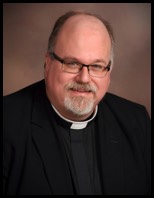Typology and Real Presence in Holy Communion
By: Dr. Gregory S. Neal
Typology is a form of Biblical interpretation in which a person, an event, or an object is understood to foreshadow a later person, event, or object. A common example of this form of Biblical Interpretation can be found in the way in which most Christians read the Old Testament as containing multiple foreshadowings of the life, death and resurrection of Jesus Christ.
For example, Abraham’s attempted sacrifice of Isaac is often understood as being an Old Testament type of the sacrificial death of Jesus on the cross for our sins. Another example of an Old Testament typology can be found in the Israelite practice of circumcision: just as, for males, circumcision was the outward sign of membership in the covenant community, so also baptism is the outward sign of membership, for all Christians, in the Body of Christ. In other words, baptism in the New Testament cast its shadow into the Old Testament, creating the "type" of Hebrew circumcision.
This method of interpretation should not be understood as, in any way, invalidating the original meaning of the Old Testament persons, places, or things which are identified as types; rather, a new layer of interpretation is being applied atop the original revelation. In other words, a deeper understanding is being drawn from the Old Testament in direct relation to a New Testament application. This should enrich both our Christian experience and our appreciation for our Jewish heritage.
This kind of Biblical interpretation is nothing new. Indeed, the Apostles themselves were not averse to pointing out similar kinds of typologies. For instance, Peter asserted that the Biblical flood was actually a Type of Christian baptism. Likewise, Paul pointed out that Adam was a Type of Jesus Christ ("the Second Adam"), while the author of the Letter to the Hebrews affirmed that Melchizedek was a Type of Christ in his high priestly ministry. In other words, typological interpretations of Old Testament persons or events can be found within the pages of the New Testament itself. Often such typologies are useful in helping to explain exceedingly difficult concepts, a fact which the New Testament authors knew and exploited.
It should come as no surprise, therefore, that typological interpretations have been a favorite among Christians for many centuries. Indeed, it is one of my favorites; it can be very handy when and where the theological concepts have become deep but the Biblical foundations remain agonizingly thin. For instance, how are we to understand the meaning of Jesus’ words: "Take, eat; this is my body?" This question is so difficult that Christians have approached it from many different directions. In each case, the scriptural foundation is very thin or even non-existent; for the most part understanding has been rooted in perspective and preconception.
Our Baptist brothers and sisters prefer to understand Jesus’ words metaphorically: the bread reminds them of Jesus, but it’s not really his body. As such, the bread is viewed as merely a token of obedience, of which they partake because Jesus so ordered it. Unfortunately, they have no biblical basis for this idea. Nowhere does Jesus say "this bread is like my body" or "the wine is like my blood." He affirms that it is his body. How?
Our Roman Catholic brothers and sisters prefer to understand Jesus’ words literally: the substance of the bread has become the literal body of Jesus. They understand this transformation as being necessary for the elements to convey the Real Presence of Jesus. In short, the bread has become Jesus.
I want to propose another approach. I believe that we may reasonably understand Jesus’ words typologically: the body and blood of Jesus, as he was crucified on the cross, casts a shadow backward to the Last Supper and forward to our Communion Tables. When we come to the Altar and eat and drink with faith, we are blessed to encounter, through the Types of bread and wine, the body and blood of Jesus. As is true with all typologies, the shadow is less substantial than that which casts it; hence, the bread’s nature as bread is less important than Jesus’ affirmation of it as his body. By receiving the elements with our faith focused upon Christ, we make contact through the shadow of the type with that which cast the shadow, the Real Presence of Jesus.*
© 2001, Dr. Gregory S. Neal
All Rights Reserved
* After the publication of this article the United Methodist Church's study Commission on Holy Communion published its report to the 2004 General Conference in which it talks about the Real Presence of Jesus as being a "Holy Mystery." I certainly affirm this idea and view it as being both Anglican and Methodist in flavor. Nevertheless, I also believe that a typological approach to the question can acknowledge the UMC's desire to maintain the holy mystery of the Divine Presence while affirming its reality. After all, how the type casts the shadow backwards and forwards and enables the receipt of the Real Presence by partaking of the shadow element is, in and of itself, something of a metaphysical, mystical mystery. Indeed, one of the criticisms of my typological approach to the Real Presence is that it really doesn't solve any problems: it just gives us additional theological jargon with which we can talk about it. (GSN - June, 2004)

As a popular teacher, preacher, and retreat leader, Dr. Neal is known for his ability to translate complex theological concepts into common, everyday terms. His preaching and teaching ministry is in demand around the world, and he is available for public engagements. He is the author of several books, including Grace Upon Grace: Sacramental Theology and the Christian Life, which is in its second edition, and Seeking the Shepherd's Arms: Reflections from the Pastoral Side of Life, a work of devotional literature. Both of these books are currently available from many book stores, including Cokesbury, Barnes And Noble, and Amazon.